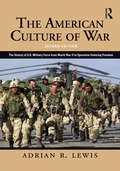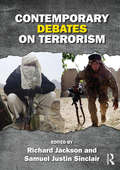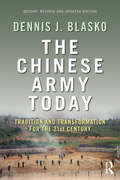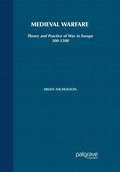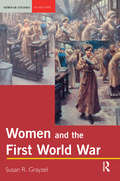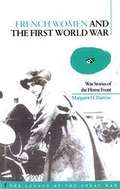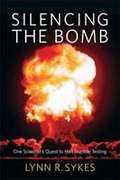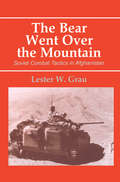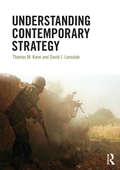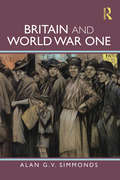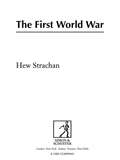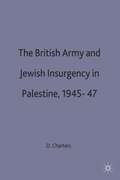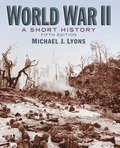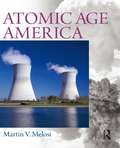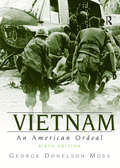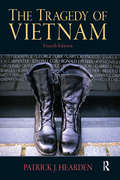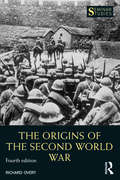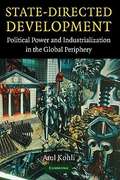- Table View
- List View
The American Culture of War: A History of US Military Force from World War II to Operation Enduring Freedom
by Adrian R. LewisThe American Culture of War presents a sweeping, critical examination of every major American war of the late 20th century: World War II, Korea, Vietnam, the First and Second Persian Gulf Wars, through to Operation Enduring Freedom. Lewis deftly traces the evolution of US military strategy, offering an original and provocative look at the motives people and governments used to wage war, the debates among military personnel, the flawed political policies that guided military strategy, and the civilian perceptions that characterized each conflict. Now in its second edition, The American Culture of War has been completely revised and updated. New features include: Completely revised and updated chapters structured to facilitate students’ ability to compare conflicts New chapters on Operation Iraqi Freedom and the current conflict in Afghanistan New conclusion discussing the American culture of war and the future of warfare Over fifty maps, photographs, and images to help students visualize material Expanded companion website with additional pedagogical material for both students and researchers. The American Culture of War is a unique and invaluable survey of over seventy years of American military history, perfect for any student of America’s modern wars. For additional information and classroom resources please visit The American Culture of War companion website at www.routledge.com/cw/lewis.
Contemporary Debates on Terrorism (PDF)
by Richard Jackson Samuel Justin SinclairContemporary Debates on Terrorism is an innovative new textbook, addressing a number of key issues in contemporary terrorism studies from both 'traditional' and 'critical' perspectives. In recent years the terrorism studies field has grown significantly, with an increasing number of scholars beginning to debate the complex dynamics underlying this category of violence. Within the broader field, there are many identifiable controversies and issues which divide scholarly opinion, a number of which are discussed in this text: Theoretical issues, such as the definition of terrorism and state terrorism; Substantive issues, including the threat posed by al Qaeda and the utility of different responses to terrorism; Ethical issues, encompassing the torture of terrorist suspects and targeted assassination The format of the volume involves a leading scholar taking a particular position on the controversy, followed by an opposing or alternative viewpoint written by another contributor. In addition to the pedagogic value of allowing students to read opposing arguments in one place, the volume will also be important for providing an overview of the state of the field and its key lines of debate. Contemporary Debates on Terrorism will be essential reading for all students of terrorism and political violence, critical terrorism studies, critical security studies, security studies and IR in general.
The Chinese Army Today: Tradition and Transformation for the 21st Century
by Dennis J. BlaskoThe Chinese Army Today is a comprehensive study of the Chinese military, examining its ground forces in a level of detail not found in any other contemporary works. This new, revised edition has been fully updated to take account of recent changes in the institution. In 1999, the military modernization program of the Chinese People’s Liberation Army increased in intensity and achieved a focus not seen in the previous two decades. Based primarily on actual Chinese sources, this book details these changes and puts them in the context of the many traditions that still remain. Written by a retired professional military officer who has served in China, the text uses first-hand observation of the Chinese military and three decades of military experience to weave many disparate threads from official Chinese statements, documents, and media reports into an integrated whole. The author also conducts an in-depth exploration into the many forces that constitute the People’s Liberation Army. This is an essential book for all students of Chinese military and security affairs, and highly recommended for students of Chinese Politics, Asian Security, and International Relations and Strategic Studies, in general.
The Chinese Army Today: Tradition and Transformation for the 21st Century
by Dennis J. BlaskoThe Chinese Army Today is a comprehensive study of the Chinese military, examining its ground forces in a level of detail not found in any other contemporary works. This new, revised edition has been fully updated to take account of recent changes in the institution. In 1999, the military modernization program of the Chinese People’s Liberation Army increased in intensity and achieved a focus not seen in the previous two decades. Based primarily on actual Chinese sources, this book details these changes and puts them in the context of the many traditions that still remain. Written by a retired professional military officer who has served in China, the text uses first-hand observation of the Chinese military and three decades of military experience to weave many disparate threads from official Chinese statements, documents, and media reports into an integrated whole. The author also conducts an in-depth exploration into the many forces that constitute the People’s Liberation Army. This is an essential book for all students of Chinese military and security affairs, and highly recommended for students of Chinese Politics, Asian Security, and International Relations and Strategic Studies, in general.
Medieval Warfare: Theory And Practice Of War In Europe, 300-1500
by Helen NicholsonWarfare in medieval times was never static or predictable - although there were ideals and conventions to follow, in the field commanders had to use their initiative and adapt to the needs of the moment. In this concise, wide-ranging study, Helen Nicholson provides the essential introductory guide to a fascinating subject. Medieval Warfare - surveys and summarises current debates and modern research into warfare throughout the whole of the medieval period across Europe - sets medieval warfare theory and practice firmly into context as a continuation and adaptation of practice under the Roman Empire, tracing its change and development across more than a millennium - considers military personnel, buildings and equipment, as well as the practice of warfare by land and sea
Women And The First World War (PDF)
by Susan R. GrayzelWomen and the First World War provides an introduction to the experiences and contributions of women during this important turning point in history. In addition to exploring women's relationship to the war in each of the main protagonist states, the book also looks at the wide-ranging effects of the war on women in Africa, Asia, Australia, New Zealand and North America. Topical in its approach, the book highlights: The heated public debates about women's social. cultural and political roles that the war inspired Thier varied experiences of war Women's representation in propaganda Their roles in peace movements and revolutionary activity that grew out of the war The consequences of the war for women in its immediate aftermath
French Women And The First World War: War Stories Of The Home Front (PDF)
by Margaret Darrow Margaret H. Darrow Margaret H. H. Darrow H. MargaretDespite acts of female heroism, popular memory, as well as official memorialization in monuments and historic sites, has ignored French women's role in the First World War. This book explores stories that were never told and why they were not. These include the experiences of French women in the war, the stories they themselves told about these experiences and how French society interpreted them. The author examines the ways French women served their country - from charity work, nursing and munitions manufacture to volunteering for military service and espionage. In tracing stories about war heroines, but also about villainesses like Mata Hari, this fascinating study shows what these stories reveal about French understanding of the war, their hopes and fears for the future. While the masculine war story was unitary and unchanging, the feminine story was multiple and shifting. Initially praised for their voluntary mobilization, women's claims of patriotism were undercut by criticisms as the war bogged down in the trenches. Were nurses giving solace or seeking romance? Were munitions workers patriots or profiteers? The prosecutions of Mata Hari for espionage and H#65533;l'ne Brion for subversion show how attitudes to women's claim of patriotism changed. French women's relationship to the war called into question ideas about gender, definitions of citizenship and national identity. This book is the first study of women at war to treat both their experiences and its representations, which shaped nationalism, war and gender for the rest of the twentieth century. It makes an important contribution to the burgeoning history of collective memory and of the First World War.
Silencing The Bomb: One Scientist's Quest To Halt Nuclear Testing
by Lynn R. SykesIn December 2016, the Bulletin of Atomic Scientists moved their iconic "Doomsday Clock" thirty seconds forward to two and a half minutes to midnight, the latest it has been set since 1952, the year of the first United States hydrogen bomb test. But a group of scientists--geologists, engineers, and physicists--has been fighting to turn back the clock. Since the dawn of the Cold War, they have advocated a halt to nuclear testing, their work culminating in the Comprehensive Test Ban Treaty, which still awaits ratification from China, Iran, North Korea--and the United States. The backbone of the treaty is every nation's ability to independently monitor the nuclear activity of the others. The noted seismologist Lynn R. Sykes, one of the central figures in the development of the science and technology used in monitoring, has dedicated his career to halting nuclear testing. In Silencing the Bomb, he tells the inside story behind scientists' quest for disarmament. Called upon time and again to testify before Congress and to inform the public, Sykes and his colleagues were, for much of the Cold War, among the only people on earth able to say with certainty when and where a bomb was tested and how large it was. Methods of measuring earthquakes, researchers realized, could also detect underground nuclear explosions. When politicians on both sides of the Iron Curtain attempted to sidestep disarmament or test ban treaties, Sykes was able to deploy the nascent science of plate tectonics to reveal the truth. Seismologists' discoveries helped bring about treaties limiting nuclear testing, but it was their activism that played a key role in the effort for peace. Full of intrigue, international politics, and hard science used for the global good, Silencing the Bomb is a timely and necessary chronicle of one scientist's efforts to keep the clock from striking midnight.
The Bear Went Over the Mountain: Soviet Combat Tactics in Afghanistan
by Lester W. GrauThis collection of vignettes was written by Soviet junior officers describing their experiences fighting the Mujahideen guerillas. It is not a history of the Soviet-Afghan war, but snapshots of combat as seen by young platoon leaders, company commanders, battalion commanders and military advisers.
The Bear Went Over the Mountain: Soviet Combat Tactics in Afghanistan
by Lester W. GrauThis collection of vignettes was written by Soviet junior officers describing their experiences fighting the Mujahideen guerillas. It is not a history of the Soviet-Afghan war, but snapshots of combat as seen by young platoon leaders, company commanders, battalion commanders and military advisers.
Understanding Contemporary Strategy
by Thomas M. Kane David J. LonsdaleUnderstanding Contemporary Strategy provides an accessible and comprehensive introduction to the theory and practice of modern strategy. Covering all the main issues in the field, the book explores the major themes through a combination of classical and modern strategic theory, history and current practice. The book is split into three main sections: Definition and Context : including discussion of the human, technological, intelligence, ethical and grand-strategic dimensions Strategy in the Geographic Environments: land, sea, air and space Contemporary Strategic Challenges: terrorism, insurgency and nuclear strategy. Each chapter presents the reader with a succinct summary of the topic, but also provides a challenging analysis of current issues, supporting students with pedagogical features such as suggested further reading, boxed case studies and study questions. This book will be essential reading for upper-level students of strategic studies, war studies, military history and international security.
Britain and World War One
by Alan G. SimmondsThe First World War appears as a fault line in Britain’s twentieth-century history. Between August 1914 and November 1918 the titanic struggle against Imperial Germany and her allies consumed more people, more money and more resources than any other conflict that Britain had hitherto experienced. For the first time, it opened up a Home Front that stretched into all parts of the British polity, society and culture, touching the lives of every citizen regardless of age, gender and class: vegetables were even grown in the gardens of Buckingham Palace. Britain and World War One throws attention on these civilians who fought the war on the Home Front. Harnessing recent scholarship, and drawing on original documents, oral testimony and historical texts, this book casts a fresh look over different aspects of British society during the four long years of war. It revisits the early war enthusiasm and the making of Kitchener’s new armies; the emotive debates over conscription; the relationships between politics, government and popular opinion; women working in wartime industries; the popular experience of war and the question of social change. This book also explores areas of wartime Britain overlooked by recent histories, including the impact of the war on rural society; the mobilization of industry and the importance of technology; responses to air raids and food and housing shortages; and the challenges to traditional social and sexual mores and wartime culture. Britain and World War One is essential reading for all students and interested lay readers of the First World War.
Britain and World War One
by Alan G. SimmondsThe First World War appears as a fault line in Britain’s twentieth-century history. Between August 1914 and November 1918 the titanic struggle against Imperial Germany and her allies consumed more people, more money and more resources than any other conflict that Britain had hitherto experienced. For the first time, it opened up a Home Front that stretched into all parts of the British polity, society and culture, touching the lives of every citizen regardless of age, gender and class: vegetables were even grown in the gardens of Buckingham Palace. Britain and World War One throws attention on these civilians who fought the war on the Home Front. Harnessing recent scholarship, and drawing on original documents, oral testimony and historical texts, this book casts a fresh look over different aspects of British society during the four long years of war. It revisits the early war enthusiasm and the making of Kitchener’s new armies; the emotive debates over conscription; the relationships between politics, government and popular opinion; women working in wartime industries; the popular experience of war and the question of social change. This book also explores areas of wartime Britain overlooked by recent histories, including the impact of the war on rural society; the mobilization of industry and the importance of technology; responses to air raids and food and housing shortages; and the challenges to traditional social and sexual mores and wartime culture. Britain and World War One is essential reading for all students and interested lay readers of the First World War.
The First World War: A New History
by Hew StrachanA brilliant and penetrating new history of the First World War by one of the world's foremost experts on the conflict. Reissued with a new introduction from the author. Hew Strachan is one of the world's foremost experts on the Great War of 1914-18. His on-going three-volume history of the conflict, the first of which was published in 2001, is likely to become the standard academic reference work: Max Hastings called it 'one of the most impressive books of modern history in a generation', while Richard Holmes hailed it as a 'towering achievement'. Now, Hew Strachan brings his immense knowledge to a one-volume work aimed squarely at the general reader. The inspiration behind the major Channel 4 series of the same name, to which Hew was chief consultant, THE FIRST WORLD WAR is a significant addition to the literature on this subject, taking as it does a uniquely global view of what is often misconceived as a prolonged skirmish on the Western Front. Exploring such theatres as the Balkans, Africa and the Ottoman Empire, Strachan assesses Britain's participation in the light of what became a struggle for the defence of liberalism, and show how the war shaped the 'short' twentieth century that followed it. Accessible, compelling and utterly convincing, this is modern history writing at its finest.
British Army and Jewish Insurgency in Palestine, 1945-47: Studies in Military and Strategic History (PDF)
by David A. ChartersThe first comprehensive scholarly study of the British Army's campaign against the Jewish insurgency in postwar Palestine, this book shows how outdated doctrine, traditional resistance to change, and postwar turbulence hampered the army's efforts to modify its counter-insurgency tactics. It also shows why the security forces failed to develop intelligence sufficient to defeat the insurgents.
World War II: A Short History
by Michael J. LyonsHighly regarded for its concise clarification of the complexities of World War II, this book illuminates the origins, course, and long-range effects of the war. It provides a balanced account that analyzes both the European and Pacific theaters of operations and the connections between them. The Fifth Edition incorporates new material based on the latest scholarship, offering updated conclusions on key topics and expanded coverage throughout.
World War II: A Short History
by Michael J. LyonsHighly regarded for its concise clarification of the complexities of World War II, this book illuminates the origins, course, and long-range effects of the war. It provides a balanced account that analyzes both the European and Pacific theaters of operations and the connections between them. The Fifth Edition incorporates new material based on the latest scholarship, offering updated conclusions on key topics and expanded coverage throughout.
Atomic Age America
by Martin V. MelosiAtomic Age America looks at the broad influence of atomic energy¿focusing particularly on nuclear weapons and nuclear power¿on the lives of Americans within a world context. The text examines the social, political, diplomatic, environmental, and technical impacts of atomic energy on the 20th and 21st centuries, with a look back to the origins of atomic theory.
Vietnam: An American Ordeal
by George Donelson MossThis book provides a comprehensive narrative history of U.S. involvement in Southeast Asia, from 1942 to 1975--with a concluding section that traces U.S.-Vietnam relations from the end of the war in 1975 to the present. Unlike most general histories of U.S. involvement in Vietnam--which are either conventional diplomatic or military histories--this volume synthesizes the perspectives to explore both dimensions of the struggle in greater depth, elucidating more of the complexities of the U.S.-Vietnam entanglement. It explains why Americans tried so hard for so long to stop the spread of Communism into Indochina, and why they failed. Key topics: The Fall of Saigon: The End as Prelude. Vietnam: A Place and A People. The Elephant and the Tiger. An Experiment in Nation Building. Raising the Stakes. Going to War. The Chain of Thunders. The Year of the Monkey. A War to End a War. The End of the Tunnel. Market: For anyone curious to know about the long American involvement in Southeast Asia, 1942-1975.
Vietnam: An American Ordeal
by George Donelson MossThis book provides a comprehensive narrative history of U.S. involvement in Southeast Asia, from 1942 to 1975--with a concluding section that traces U.S.-Vietnam relations from the end of the war in 1975 to the present. Unlike most general histories of U.S. involvement in Vietnam--which are either conventional diplomatic or military histories--this volume synthesizes the perspectives to explore both dimensions of the struggle in greater depth, elucidating more of the complexities of the U.S.-Vietnam entanglement. It explains why Americans tried so hard for so long to stop the spread of Communism into Indochina, and why they failed. Key topics: The Fall of Saigon: The End as Prelude. Vietnam: A Place and A People. The Elephant and the Tiger. An Experiment in Nation Building. Raising the Stakes. Going to War. The Chain of Thunders. The Year of the Monkey. A War to End a War. The End of the Tunnel. Market: For anyone curious to know about the long American involvement in Southeast Asia, 1942-1975.
Tragedy of Vietnam
by Patrick J HeardenFor courses on the Vietnam War, 20th century world history and American diplomatic history. Also appropriate as a supplemental text for U.S. history survey courses and history of Asia courses. Brief and accessible text that provides comprehensive coverage of the causes and consequences of the Vietnam War. The Tragedy of Vietnam provides extensive background on the Vietnam War, the relevant history of Southeast Asia and the consequences of the Vietnam conflict on the region. Author Patrick Hearden examines the key decisions and questions surroudning the tragic American entanglement in Vietnam, providing readers with a fascinating discussion of why the United States became involved in this war and why this involvement persisted for nearly a quarter of a century. This book covers the social, economic, ideological, diplomatic and military aspects of the Vietnam War.
Tragedy of Vietnam
by Patrick J HeardenFor courses on the Vietnam War, 20th century world history and American diplomatic history. Also appropriate as a supplemental text for U.S. history survey courses and history of Asia courses. Brief and accessible text that provides comprehensive coverage of the causes and consequences of the Vietnam War. The Tragedy of Vietnam provides extensive background on the Vietnam War, the relevant history of Southeast Asia and the consequences of the Vietnam conflict on the region. Author Patrick Hearden examines the key decisions and questions surroudning the tragic American entanglement in Vietnam, providing readers with a fascinating discussion of why the United States became involved in this war and why this involvement persisted for nearly a quarter of a century. This book covers the social, economic, ideological, diplomatic and military aspects of the Vietnam War.
The Origins of the Second World War
by Richard OveryExploring the reasons why the Second World War broke out in September 1939 and why a European conflict developed into a war that spanned the globe, The Origins of the Second World War argues that this was not just ‘Hitler’s War’ but one that had its roots and origins in the decline of the old empires of Britain and France and the rise of ambitious new powers in Germany, Italy and Japan who wanted large empires of their own. This fourth edition has been revised throughout, covering the origins of the war from its background in the First World War to its expansion to embrace the Soviet Union, Japan and the United States by the end of 1941. Creating a comprehensive and analytical narrative while remaining a succinct overview of the subject, this book takes a thematic approach to the complex range of events that culminated in global warfare, discussing factors such as economic rivalry, rearmament and domestic politics and emphasising that any explanation of the outbreak of hostilities must be global in scope. Containing updated references and primary source documents alongside a glossary, a chronology of key events and a Who’s Who of important figures, this book is an invaluable introduction for any student of this fascinating period.
The Origins of the Second World War
by Richard OveryExploring the reasons why the Second World War broke out in September 1939 and why a European conflict developed into a war that spanned the globe, The Origins of the Second World War argues that this was not just ‘Hitler’s War’ but one that had its roots and origins in the decline of the old empires of Britain and France and the rise of ambitious new powers in Germany, Italy and Japan who wanted large empires of their own. This fourth edition has been revised throughout, covering the origins of the war from its background in the First World War to its expansion to embrace the Soviet Union, Japan and the United States by the end of 1941. Creating a comprehensive and analytical narrative while remaining a succinct overview of the subject, this book takes a thematic approach to the complex range of events that culminated in global warfare, discussing factors such as economic rivalry, rearmament and domestic politics and emphasising that any explanation of the outbreak of hostilities must be global in scope. Containing updated references and primary source documents alongside a glossary, a chronology of key events and a Who’s Who of important figures, this book is an invaluable introduction for any student of this fascinating period.
State-directed Development: Political Power And Industrialization In The Global Periphery (PDF)
by Atul KohliWhy have some developing country states been more successful at facilitating industrialization than others? An answer to this question is developed by focusing both on patterns of state construction and intervention aimed at promoting industrialization. Four countries are analyzed in detail - South Korea, Brazil, India, and Nigeria - over the twentieth century. The states in these countries varied from cohesive-capitalist (mainly in Korea), through fragmented-multiclass (mainly in India), to neo-patrimonial (mainly in Nigeria). It is argued that cohesive-capitalist states have been most effective at promoting industrialization and neo-patrimonial states the least. The performance of fragmented-multiclass states falls somewhere in the middle. After explaining in detail as to why this should be so, the study traces the origins of these different state types historically, emphasizing the role of different types of colonialisms in the process of state construction in the developing world.
